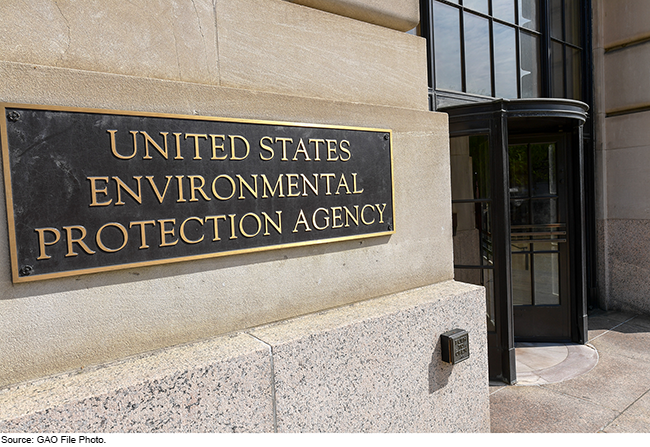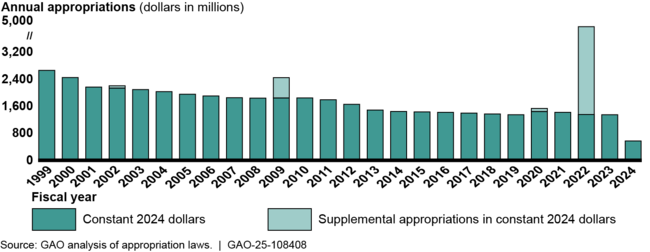Superfund: Many Factors Can Affect Cleanup of Sites Across the U.S.
Fast Facts
The Environmental Protection Agency lists some of the nation's most seriously contaminated sites on its Superfund National Priorities List. As of March 5, 2025, the list included 1,340 active sites across the United States.
We testified that appropriations to the Superfund program generally declined from fiscal years 1999 through 2024. The program also received supplemental appropriations in some years.
Our prior work identified some factors that EPA officials said can affect the timeliness of site cleanup, such as:
technical complexity due to site characteristics
the discovery of new contaminants at a site
limited funding and cleanup staff

Highlights
What GAO Found
Appropriations for the Superfund program have generally declined since fiscal year 1999. Specifically, these appropriations declined from about $2.6 billion in fiscal year 1999 to about $537 million in fiscal year 2024. In fiscal year 2023, the Treasury collected $1.44 billion in Superfund taxes, which was available to the program in fiscal year 2024 as it transitioned to a combination of base and tax funding. The Superfund program also received supplemental appropriations in some years. For example, the American Recovery and Reinvestment Act of 2009 provided an additional $600 million in fiscal year 2009, and the Infrastructure Investment and Jobs Act provided an additional $3.5 billion in fiscal year 2022.
Superfund Program Appropriations, Fiscal Years 1999–2024

Note: After authority for Superfund taxes expired at the end of 1995, they began to be reinstated in 2021 and take effect in 2022. In fiscal year 2023, the Treasury collected $1.44 billion in Superfund taxes, which was available to the program in fiscal year 2024 as it transitioned to a combination of base and tax funding.
As of March 5, 2025, the U.S. Environmental Protection Agency's (EPA) National Priorities List (NPL) had 1,340 active sites across the U.S. About 90 percent of these sites are nonfederal. According to prior GAO analyses of EPA data, from fiscal year 1999 through fiscal year 2013, the numbers of new sites added to and deleted from the NPL generally declined. According to EPA officials, the decline in the number of nonfederal sites deleted from the NPL was because of the decline in annual appropriations and the fact that the sites remaining on the NPL were more complex and took more time and money to clean up.
In its prior work, GAO identified factors that EPA officials characterized as affecting the timeliness of NPL site cleanups, including the following:
- Discovery of new contaminants or a change in the extent of contamination.
- Lack of potentially responsible parties to contribute to cleanup costs.
- Technical complexity of some sites (e.g., sediment sites).
- Limited agency resources, such as decreases in funds and regional staff to perform the cleanup.
Why GAO Did This Study
EPA is responsible for administering the Superfund program to clean up sites contaminated by hazardous substances. EPA lists some of the nation's most seriously contaminated sites on the NPL.
Superfund sites include mining sites, landfills, and former manufacturing sites. Sites may include a variety of contaminants, such as polychlorinated biphenyls, lead, and arsenic. EPA may select different types of remedies to clean up these sites.
For nonfederal sites, EPA can, for example, carry out the cleanup itself or oversee cleanup conducted by parties responsible for the contamination, known as potentially responsible parties.
Cleanups are often expensive and lengthy. Historically, the program received money from sources such as taxes, appropriations, and recoveries from potentially responsible parties. Authority for the taxes expired at the end of 1995 and began to be reinstated in 2021 and take effect in 2022.
This statement discusses (1) trends in Superfund program appropriations, (2) numbers of NPL sites and EPA-identified reasons for changes, and (3) factors EPA officials identified as affecting the timeliness of NPL site cleanups.
GAO based this statement on its 2009, 2015, and 2016 reports about the Superfund program. Appropriations data presented in the 2015 report were updated for this statement.
For more information, contact J. Alfredo Gómez at GomezJ@gao.gov.
